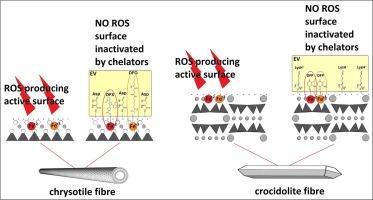通过将纤维参数与致癌物的关键特征联系起来,缩小矿物纤维的毒性与致癌性之间的差距:激发石棉诱发癌症预防策略的综合模型
IF 2.9
Q2 TOXICOLOGY
引用次数: 0
摘要
背景当今,世界上许多研究小组都在努力全面了解石棉等有害矿物纤维的致癌机制,以制定有效的癌症预防策略和疗法。按照这一研究思路,我们的工作试图完成一个模型,旨在评估矿物纤维的物理-晶体-化学和形态参数如何以及在多大程度上促使在体内产生不利影响,从而导致致癌。方法 我们系统地收集了商业温石棉、标准 UICC 青石棉和硅灰石的体外毒理学测试,这些测试提供了国际癌症研究协会(IARC)采用的致癌物 10 个关键特征的信息。通过对体外数据的分析,我们可以评估导致每种调查纤维的致癌物主要特征发生变化的主要纤维参数及其影响强度。对于温石棉,除了长度之外,我们还发现对 KCs 有重大影响的纤维参数是表面积和溶解速率以及相关的金属(即铁)释放速度。对于青石棉来说,这些参数是纤维长度、铁含量和相关参数,如亚铁含量、铁核度、过渡金属含量和 zeta 电位。我们可以推测,未来的个性化预防疗法将以纤维为靶标,利用表面工程纳米载体和活性复合物对纤维的表面电荷进行选择。对于温石棉,建议使用可螯合 Fe2+ 的去铁胺和优先螯合 Fe3+ 的去氧胺复合物,并通过天冬氨酸将其锚定在温石棉的硅表面。对于青石棉,建议使用能螯合 Fe3+ 和 Fe2+ 的去铁酮,再加上赖氨酸,以吸引青石棉表面的二氧化硅。本文章由计算机程序翻译,如有差异,请以英文原文为准。

Bridging the gap between toxicity and carcinogenicity of mineral fibres by connecting the fibre parameters to the key characteristics of carcinogens: A comprehensive model inspiring asbestos-induced cancer prevention strategies
Background
Today, many research groups in the world are struggling to fully understand the mechanisms leading to the carcinogenesis of hazardous mineral fibres, like asbestos, in view of devising effective cancer prevention strategies and therapies. Along this research line, our work attempts the completion of a model aimed at evaluating how, and to what extent, physical-crystal-chemical and morphological parameters of mineral fibres prompt adverse effects in vivo leading to carcinogenesis.
Methods
In vitro toxicology tests that deliver information on the 10 key characteristics of carcinogens adopted by the International Association for Research on Cancer (IARC) have been systematically collected for a commercial chrysotile, standard UICC crocidolite and wollastonite. The analysis of the in vitro data allowed us to assess the major fibre parameters responsible for alterations in the key characteristics of carcinogens for each investigated fibre and the intensity of their effect.
Results
Crystal habit and density of the fibres affect exposure but are not major parameters contributing to the KCs. For chrysotile, besides length, we found that fibre parameters that greatly contribute to the KCs are the surface area and the dissolution rate with the related velocity of release of metals (namely iron). For crocidolite, they are the fibre length, iron content and related parameters like the ferrous iron content, iron nuclearity, transition metals content and zeta potential.
Conclusions
The results of our study can be a starting point for developing personalized cancer screening and prevention strategies as long as the nature of the fibre of the exposed patient is known. We can speculate on a future personalized prevention therapy targeting the fibres with surface-engineered nanocarriers with active complexes that are selective for the surface charge of the fibres. For chrysotile, a complex with deferasirox that can chelate Fe2+ and deferoxamine that preferentially chelates Fe3+ is proposed with the anchorage to the silica chrysotile surface driven by aspartic acid. For crocidolite, deferiprone chelating both Fe3+ and Fe2+ combined with lysine to attract the silica crocidolite surface is proposed.
求助全文
通过发布文献求助,成功后即可免费获取论文全文。
去求助
来源期刊

Current Research in Toxicology
Environmental Science-Health, Toxicology and Mutagenesis
CiteScore
4.70
自引率
3.00%
发文量
33
审稿时长
82 days
 求助内容:
求助内容: 应助结果提醒方式:
应助结果提醒方式:


